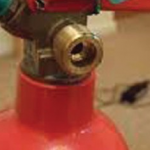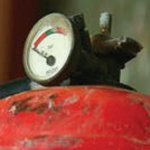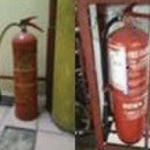Selection of a particular fire extinguisher is based on various factors such as characteristics of fire anticipated; type of building, hazard to be protected, ambient temp etc (NFPA 10). These factors are expressed as types of fire and hazard classes (low, medium, high). Special considerations are made for special hazards namely pressurized flammable liquid or gas, cooking grease etc.
Note: Usage of Halon 1211 and Halon 1301 is highly restricted in many countries as per the Montreal Protocol of 1997.
|
Defects
|
Probable causes for the defect
|
Design for Maintainability (DfM) Guidelines
|
| Missing / damaged parts or the whole unit

Misuse, wrong placement
 Extinguishing cone missing |
- Corroded if not rust resistant or exposed to very damp environment.
- Denting or abrasion due to mishandling.
- Mishandling may damage parts ( seal, trap, thread, gasket, handle etc).
- Stolen – vandalism. Mounting should be able to prevent that.
- Wrongly placed with no concern for safety rules, misuse. E.g. As door stopper.
- Hangers are broken due to corrosion, not secured to structure or used for hanging heavier extinguisher.
|
Design
-
Ensure that the locations and number of portable fire extinguishers are based on the maximum travel route (SS EN 3 Series, BS 5306-8:2012, ISO/PRF 7165).
-
Access to or visibility of extinguishers should be unobstructed. Extinguishers should be visible along an escape route (preferably near room exits, along corridors and staircases, in lobbies, and on landing).
-
The extinguishers’ body and the parts should be of approved quality to prevent rusting, early damage or deterioration (BS EN 3 series).
Construction
-
Ensure the proper positioning (designated location, hung properly with label facing out) of fire extinguishers.
- Installation of Small Fire Extinguishers (≤ 4 Kg): Hung on wall with hanger or bracket such that the handle is about 1.5m from floor. Hangers should be securely fixed.
-
Installation of Heavier Fire Extinguishers (≥ 4 Kg): Carrying handle should be about 1m from floor. Ensure that the arrangement would not hurt the person carrying it. Parts should be attached as per manufacturer’s instruction.
Maintenance
-
Conduct regular servicing to confirm required working condition. (Refer to the recommended schedules for maintenance as per BS 5306-3:2009).
-
Conduct monthly inspection to ensure that the pressure gauge is in operative range and check for any sign of corrosion of the body of the extinguisher.
-
Comply with the recharging frequency as per type of extinguisher.
-
Charging, testing and maintenance of fire extinguishers must conform to SS 578:2012 specifications.
-
Extinguishers must be recharged with the same agent only.
-
No mixing or cross contamination allowed and no overfilling. (See also BS 5306-9:2015, NFPA 10:2013).
|
Less pressure in nozzle or poor discharge
 Low pressure indicated in the fire extinguisher. This often leads to poor or no discharge |
- Irregular servicing – leaky pressure valve, poor content of extinguishing agent or clogged by the dated agent.
- Damages in nozzle such as cracked, deformed, spoilt thread etc. from mishandling or vandalism. Mounting not vandal proof.
- Illegible weight marking may leave gas cartridge partially empty.
- Extinguisher if not hydrostatically tested, may not be suitable to cater to the full pressure.
|
Design
- Ensure that the locations and number of portable fire extinguishers are based on the maximum travel route (SS EN 3 Series, BS 5306-8:2012, ISO/PRF 7165).
- Access to or visibility of extinguishers should be unobstructed. Extinguishers should be visible along an escape route (preferably near room exits, along corridors and staircases, in lobbies, and on landing).
- The extinguishers’ body and the parts should be of approved quality to prevent rusting, early damage or deterioration (BS EN 3 series).
Construction
-
Ensure the proper positioning (designated location, hung properly with label facing out) of fire extinguishers.
- Installation of Small Fire Extinguishers (≤ 4 Kg): Hung on wall with hanger or bracket such that the handle is about 1.5m from floor. Hangers should be securely fixed.
-
Installation of Heavier Fire Extinguishers (≥ 4 Kg): Carrying handle should be about 1m from floor. Ensure that the arrangement would not hurt the person carrying it. Parts should be attached as per manufacturer’s instruction.
Maintenance
-
Conduct regular servicing to confirm required working condition. (Refer to the recommended schedules for maintenance as per BS 5306-3:2009).
-
Conduct monthly inspection to ensure that the pressure gauge is in operative range and check for any sign of corrosion of the body of the extinguisher.
-
Comply with the recharging frequency as per type of extinguisher.
-
Charging, testing and maintenance of fire extinguishers must conform to SS 578:2012 specifications.
-
Extinguishers must be recharged with the same agent only.
-
No mixing or cross contamination allowed and no overfilling. (See also BS 5306-9:2015, NFPA 10:2013).
|
| Extinguishing agent unacceptable / unsuitable

Illegible label
|
- Hardening of powder in damp environment.
- Water / foam has incorrect weight or of expired date.
- Liquid become gummy if not changed in time and clogs the pressure vacuum vent or the discharge nozzle.
- Malfunction of components with time – suppression activator, proportioning device etc. Should be replaced as recommended.
- Components of nozzle cap, plug etc corroded, missing or misaligned.
- A change in type is required to suit the anticipated type of fire and hazard class. Usually happens due to change in building use.
- Illegible label- user not sure about the extinguishing agent.
|
Design
Construction
Maintenance
|
| Faulty puncture mechanism |
- Poor make.
- Thread is blunt or jammed – damaged during installation / servicing
- Corrosion of inferior quality pipes
|
Design
Construction
Maintenance
|
Fire extinguishers related issues
 Fire extinguishers not kept properly and not secured |
- Unkempt condition of fire extinguishers
- Poor accessibility and improper positioning/ location
|
Design
-
Ensure that the locations and number of portable fire extinguishers are based on the maximum travel route (SS EN 3 Series, BS 5306-8:2012, ISO/PRF 7165).
-
Access to or visibility of extinguishers should be unobstructed. Extinguishers should be visible along an escape route (preferably near room exits, along corridors and staircases, in lobbies, and on landing).
-
The extinguishers’ body and the parts should be of approved quality to prevent rusting, early damage or deterioration (BS EN 3 series).
Construction
-
Ensure the proper positioning (designated location, hung properly with label facing out) of fire extinguishers.
- Installation of Small Fire Extinguishers (≤ 4 Kg): Hung on wall with hanger or bracket such that the handle is about 1.5m from floor. Hangers should be securely fixed.
-
Installation of Heavier Fire Extinguishers (≥ 4 Kg): Carrying handle should be about 1m from floor. Ensure that the arrangement would not hurt the person carrying it. Parts should be attached as per manufacturer’s instruction.
Maintenance
-
Conduct regular servicing to confirm required working condition. (Refer to the recommended schedules for maintenance as per BS 5306-3:2009).
-
Conduct monthly inspection to ensure that the pressure gauge is in operative range and check for any sign of corrosion of the body of the extinguisher.
-
Comply with the recharging frequency as per type of extinguisher.
-
Charging, testing and maintenance of fire extinguishers must conform to SS 578:2012 specifications.
-
Extinguishers must be recharged with the same agent only.
-
No mixing or cross contamination allowed and no overfilling. (See also BS 5306-9:2015, NFPA 10:2013).
|
References
[1]
Normative References/Standards Referred to for Air Handling Unit and Fan Coil Unit




